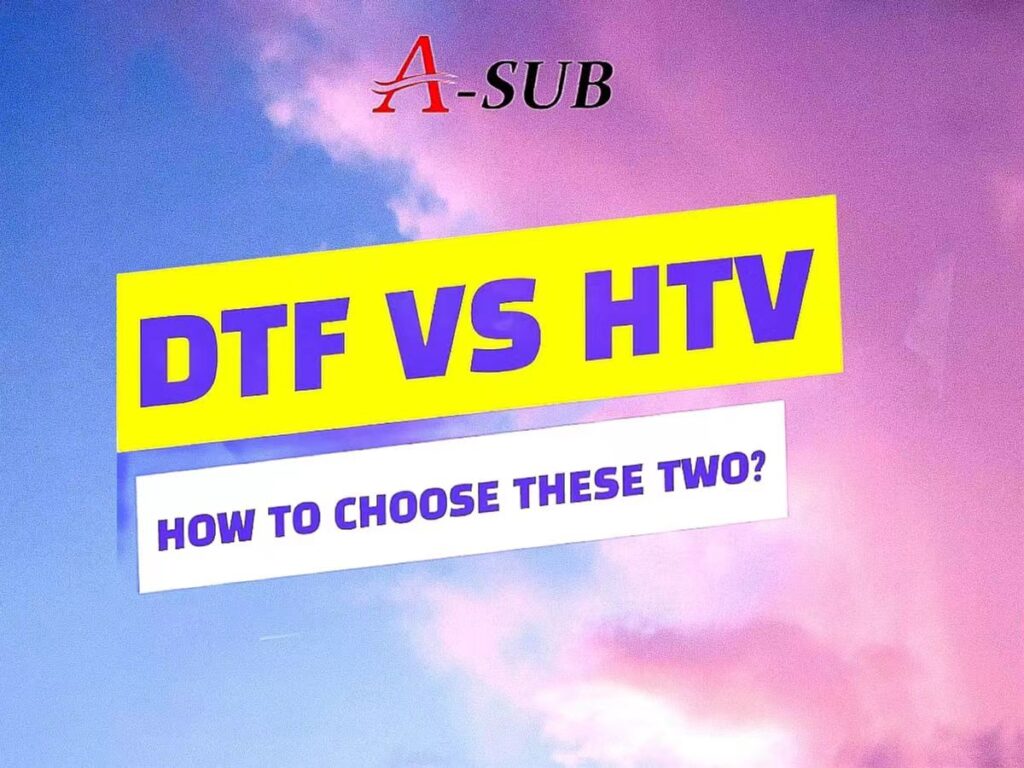Intro
In 2022, it will be everywhere, whether in fairs or in daily life. Is the DTF transfer really good? Compared with HTV, which is also a film transfer, what are its advantages? Is it really worth trying?
In the heat transfer industry, various transfer technologies have their special advantages. Different factories may have different options and preferences. However, from a fair point of view, I think DTF is indeed worth trying, and its color performance is much higher than that of HTV.
I’m going to explain the advantages of DTF over HTV in several ways in this article in detail.
Brief Introduction of DTF

DTF transfer is a kind of film transfer technology. In the transfer process, DTF transfer film, DTF ink, hot melt adhesive and other consumables are needed.
DTF Heat transfer film is a medium material for heat transfer process. The pattern printed on PET heat transfer film is transferred on the clothes through the hot melt powder that on the surface of the pattern as the transfer medium.
Two advantages of DTF that make it stand out are that it can be used on fabrics in varieties of colors and materials. The reason it works on fabrics in different materials is that the pattern is attached to the garment by hot melt adhesive. It is suitable for all fabrics in various color because it has a white ink as base.
The structure of DTF Heat sublimation film and Sublimation paper is different, only a layer of transfer film consist of anti-static coating, PET film and peelable coating.
Brief Introduction of HTV.

Heat transfer vinyl, or HTV for short, is a specialty vinyl polymer that can be used on certain fabrics and materials to create designs and promotional products. Heat transfer vinyl is one of the most common techniques used to customize fabric merchandise.
It comes in a roll or sheet form with an adhesive backing so it can be cut, weeded, and placed on a substrate for heat application.
In addition, there are also heat transfer vinyl that cannot be printed on. Such vinyl comes in a variety of colors, patterns, and characteristics – from solid colors to glossy, reflective and even glittery materials. These non-printable vinyl only requires the user to cut and weed the artwork using a vinyl cutting plotter and apply the vinyl in the same method as mentioned above.
The most common application for non-printable vinyl includes the customization of names and number onto jerseys for sports such as football and basketball.
Differences Between DTF and HTV
DTF is more convenient

Production speed is an important factor in the T-shirt printing industry.
DTF is more convenient compared with HTV. The process of using HTV is to first engrave the design on the vinyl with an engraving machine. The extra part needs to be removed, then the pattern is ironed on the garment. Finally, the PET release film is removed.
DTF printing is to first print the design on the DTF film, then cover the pattern with hot melt powder and bake it to melt. Finally, the pattern is transferred to various colors and materials by thermal transfer printing.
The DTF printing and powder curing process is an assembly line process, while the cutting process of the vinyl thermal transfer printer can only be done after the printing is completed. In addition to printing and cutting, a lot of production time is also allocated to weeding and transfer processes.
It can be seen that DTF eliminates the process of deducting excess patterns.
In detail, vinyl heat transfer requires careful weeding. If the artwork is complex, it can take hours to weed out all unnecessary parts. If the artwork contains a lot of small text, it may not be possible to knock out too small details. Also, it is often realized that some details are lost after the weeding process. Therefore, some parts need to be reprinted or re-cut to get the job done.
Instead, DTF print directly onto a coated PET film that also acts as a transfer paper. The differences lead to faster, higher productivity and efficiency.
DTF transfer result is better
No matter the color or quality, DTF transfer result is better. HTV is usually monochrome, and different textures such as reflective, luminous, metallic and flocking can be distinguished due to different processes and materials.
DTF transfer, on the other hand, can use DTF ink printing to present various colors, and can also use DTF fluorescent ink to print patterns with fluorescent effects.
Product durability is stronger

Compared with HTV, DTF can print finer lines and will not be deformed after high temperature heat transfer. The result after transfer is smooth, elastic, stretch resistant and good washing effect.
Since there is no printing on vinyl involved in DTF, there will be no extra layer of vinyl on the t-shirt. As a result, the durability of the final product will be enhanced, unlike vinyl which tends to flake over time.
The average price is lower when mass production

The consumables required for DTF transfer printing are not expensive. A single DTF film can print several patterns at the same time. Of course, DTF has some requirements in terms of equipment. So, if you just want to transfer a small batch of products and have no color requirements, DTF may not be the best choice.
But if you need to transfer complex patterns with high color requirements, and you need to produce large quantities, please choose DTF.
Conclusion
Overall, DTF has its unique advantages. If you happen to have a large amount of fabric to transfer and also have a requirement for color, DTF transfer is a good choice.
Once you have made your decision, then choose a suitable supplier. It can give you a convenient one-stop service. It not only saves time and effort, but also guarantees the quality of the product, which means you can spend the least amount of effort and money to get products with beautiful patterns and good quality.
I hope this article can be helpful to you.






